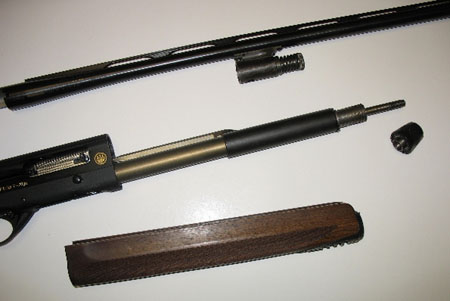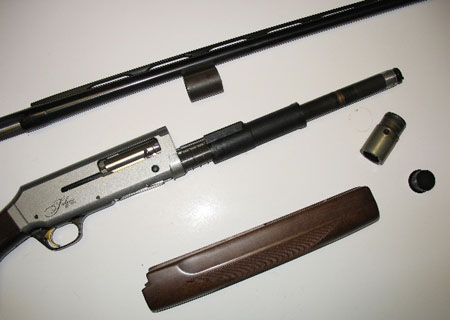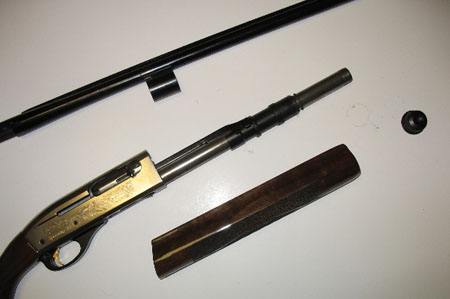|
Today's Gas-Operated Shotgun Actions The heart of autoloading gas-operated shotguns is of course the gas action itself. Here is a look at the internals of the most popular shotgun actions. Beretta Urika 2 Gas System The evolution of the current compensating AL391 Urika system was introduced as an improvement upon Beretta�s 390 gas array. The 390�s system is essentially the 300 series Beretta gas drive with a secondary gas bleed added in an attempt to handle a wider range of gas pressures past the barrel�s gas ports. Where the 390 system has a spring loaded disc held against the newly ported barrel ring by the forearm nut, the 391 version makes the secondary bleed spring system integral with the barrel itself. Why Beretta went this route remains a bit unclear. Beretta has touted the thinner and �more slender� forearm of the 391 vs. the 390 as being desirable. That is a matter of taste, but it is hard to fathom that the 20 gauge 390 forearm was in any way bulky. The 391 forearm nut itself is a case of Italian engineering run amuck, containing no less than seven parts and is prone to Frozen Nut Syndrome. Not designed for easy maintenance, it gets filthy with extended use. Beretta�s owners manual is silent on the matter of cleaning, offering no help in disassembly. Beretta has reported that the nut (with its own spring array inside) is to stop point of impact shift due to barrel warping when heated. That may be, but a super-heated barrel on the clays course may be addressed by a quick loosening and retightening of the nut that takes only moments. Whatever the real reason might be, it is a remarkably odd and complicated solution. The secondary gas bleed spring, once hand-removable on the 390, is now smaller and affixed to the barrel ring. To properly access and clean this area, you can no longer use your fingers and common hand tools, but instead are directed to use the �valve hook wrenches� (spanner wrenches) supplied with the 391. If all of this is starting to give you a headache, I can promise that you are not alone.  What can be fairly said is that the 391 system can go a very long time without maintenance in the 12 gauge platform, even if the design itself is user unfriendly and has the result of discouraging proper maintenance. I feel it is not an improvement over the prior 390 system (currently available in the Beretta 3901) and can be considered a negative for many shooters. In the case of our test gun, this improvement failed to stop the action from frequently jamming. Browning Silver Gas System The Browning Gold/Silver once-piece gas valve, dubbed the �Active Valve� by Browning, is one of the most modern gas actions available on shotguns, having made its debut in 1994. Over the last 15 years it has developed into what I consider to be the best semi-auto gas system on the market. I am not privy to the fine points and running production changes of the Gold system, but I can tell that there have been refinements. I have been advised that older gas guns were ported for lead loads, current gas systems for steel, but I am unclear as to exactly what that means. SAAMI gives shotshell manufacturers 12,000 PSI or so to work with and H. P. White data shows that 2500 - 3000 PSI is often what is left near the muzzle. The exact pressure past the ports is something that Browning and others monitor. The beauty of the Gold system is one valve assembly, no loose O rings or concoctions of loose springs. I can�t call the Gold self-cleaning, but what residue remains after firing forms right on the magazine tube, making it very easy to get to and wipe off.  The forearm nut is just a nut, the tube that drives the action back is structural polymer and the Gold Active Valve has been the basic platform from which the Winchester SX2, SX3 and the Browning Silver have been derived. Although more versatile than either the Beretta or Remington 1100 systems, it appears that the major rework this system is being given in Browning�s Maxus extends it even further. Remington 1100 Gas System Since around 1963 the Remington gas system of the 1100 has been essentially unchanged. A look at the action shows a resemblance to the Remington 870 pump, with a metal housing over the magazine tube attached to a twin action bar assembly. The metal magazine tube housing (action bar sleeve) is driven backward by an O-ring (barrel seal) that tries to seal the exhaust gas against a pair of loose beveled washers (piston seal) that reside in front of the action bar drive. The O-ring is a sacrificial part. A captured O-ring, as in most gasketing applications, wears very little. A free, dynamic O-ring, as in the 1100 application, can tear or wear very quickly. It�s a good idea to keep extra O-rings in your range bag, as your 1100 is unlikely to cycle well without one. As long as an eye is kept on the O ring, the 1100 can be very reliable. The 1100 is not as adept at cycling a wide variety of loads as some actions, as evidenced by the �barrel seal activator� added on 11-87 models.  A look at the Remington action shows why it is heavy compared to many: the steel receiver, the comparatively heavy steel action bar sleeve and the steel double action bars combine to give it more weight than the plastic and aluminum competition. Quality parts, made in the USA. What I appreciate most about the Browning and Remington treatments is that much of the fouling is easy to access and is quick to wipe away. This was true of the older Beretta 302-303 shotguns and even the 390, as compared to the current 391 Urika. |